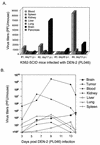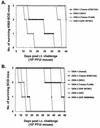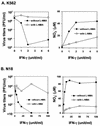Study of Dengue virus infection in SCID mice engrafted with human K562 cells
- PMID: 9811707
- PMCID: PMC110483
- DOI: 10.1128/JVI.72.12.9729-9737.1998
Study of Dengue virus infection in SCID mice engrafted with human K562 cells
Abstract
Here we report that severe combined immunodeficient (SCID) mice engrafted with human K562 cells (K562-SCID mice) can be used as an animal model to study dengue virus (DEN) infection. After intratumor injection into K562 cell masses of PL046, a Taiwanese DEN-2 human isolate, the K562-SCID mice showed neurological signs of paralysis and died at approximately 2 weeks postinfection. In addition to being detected in the tumor masses, high virus titers were detected in the peripheral blood and the brain tissues, indicating that DEN had replicated in the infected K562-SCID mice. In contrast, the SCID mice were resistant to DEN infection and the mock-infected K562-SCID mice survived for over 3 months. These data illustrate that DEN infection contributed directly to the deaths of the infected K562-SCID mice. Other serotypes of DEN were also used to infect the K562-SCID mice, and the mortality rates of the infected mice varied with different challenge strains, suggesting the existence of diverse degrees of virulence among DENs. To determine whether a neutralizing antibody against DEN in vitro was also protective in vivo, the K562-SCID mice were challenged with DEN-2 and received antibody administration at the same time or 1 day earlier. Our results revealed that the antibody-treated mice exhibited a reduction in mortality and a delay of paralysis onset after DEN infection. In contrast to K562-SCID, the persistently DEN-infected K562 cells generated in vitro invariably failed to be implanted in the mice. It seems that in the early stage of implantation, a gamma interferon activated, nitric oxide-mediated anti-DEN effect might play a role in the innate immunity against DEN-infected cells. The system described herein offers an opportunity to explore DEN replication in vivo and to test various antiviral protocols in infected hosts.
Figures






Similar articles
-
Evaluation of the severe combined immunodeficient (SCID) mouse as an animal model for dengue viral infection.Am J Trop Med Hyg. 1995 May;52(5):468-76. doi: 10.4269/ajtmh.1995.52.468. Am J Trop Med Hyg. 1995. PMID: 7771614
-
Development of a novel mouse model for dengue virus infection.Virology. 1999 Oct 10;263(1):70-7. doi: 10.1006/viro.1999.9887. Virology. 1999. PMID: 10544083
-
Vaccine candidates derived from a novel infectious cDNA clone of an American genotype dengue virus type 2.BMC Infect Dis. 2004 Oct 4;4:39. doi: 10.1186/1471-2334-4-39. BMC Infect Dis. 2004. PMID: 15461822 Free PMC article.
-
Animal models of dengue virus infection.Viruses. 2012 Jan;4(1):62-82. doi: 10.3390/v4010062. Epub 2012 Jan 9. Viruses. 2012. PMID: 22355452 Free PMC article. Review.
-
Dengue virus life cycle: viral and host factors modulating infectivity.Cell Mol Life Sci. 2010 Aug;67(16):2773-86. doi: 10.1007/s00018-010-0357-z. Epub 2010 Apr 6. Cell Mol Life Sci. 2010. PMID: 20372965 Free PMC article. Review.
Cited by
-
Potential Role of Flavivirus NS2B-NS3 Proteases in Viral Pathogenesis and Anti-flavivirus Drug Discovery Employing Animal Cells and Models: A Review.Viruses. 2021 Dec 28;14(1):44. doi: 10.3390/v14010044. Viruses. 2021. PMID: 35062249 Free PMC article. Review.
-
Successful propagation of flavivirus infectious cDNAs by a novel method to reduce the cryptic bacterial promoter activity of virus genomes.J Virol. 2011 Mar;85(6):2927-41. doi: 10.1128/JVI.01986-10. Epub 2011 Jan 12. J Virol. 2011. PMID: 21228244 Free PMC article.
-
Lovastatin delays infection and increases survival rates in AG129 mice infected with dengue virus serotype 2.PLoS One. 2014 Feb 21;9(2):e87412. doi: 10.1371/journal.pone.0087412. eCollection 2014. PLoS One. 2014. PMID: 24586275 Free PMC article.
-
Blocking of the alpha interferon-induced Jak-Stat signaling pathway by Japanese encephalitis virus infection.J Virol. 2004 Sep;78(17):9285-94. doi: 10.1128/JVI.78.17.9285-9294.2004. J Virol. 2004. PMID: 15308723 Free PMC article.
-
Gamma interferon (IFN-γ) receptor restricts systemic dengue virus replication and prevents paralysis in IFN-α/β receptor-deficient mice.J Virol. 2012 Dec;86(23):12561-70. doi: 10.1128/JVI.06743-11. Epub 2012 Sep 12. J Virol. 2012. PMID: 22973027 Free PMC article.
References
-
- Amor S, Scallan M F, Morris M M, Dyson H, Fazakerley J K. Role of immune responses in protection and pathogenesis during Semliki Forest virus encephalitis. J Gen Virol. 1996;77:281–291. - PubMed
-
- Boonpucknavig S, Vuttiviroj O, Boonpucknavig V. Infection of young adult mice with dengue virus type 2. Trans R Soc Trop Med Hyg. 1981;75:647–653. - PubMed
Publication types
MeSH terms
Substances
LinkOut - more resources
Full Text Sources
Other Literature Sources
Medical

